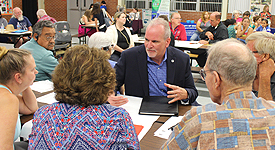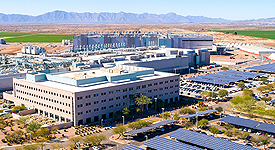
Article originally appeared in SanTan Sun News on July 18, 2021.
Welcome to monsoon season in Chandler. Tis the season of unknowns, as the forecast is uncertain about how much, or how little, the traditional storms of the season will impact the community. The one thing you can be certain of is that teams from the City of Chandler are prepared to respond when they are needed.
Some of the common issues that can occur are caused by heavy rain or strong winds.
One of the most common hazards is blocked roadways or sidewalks when trees are knocked down due to the strong winds that are typical during monsoons. There is no way to predict where they will fall, but many times these trees cause hazards to drivers and pedestrians as they block roadways and sidewalks. When this occurs during normal weekday hours, you should call the streets division at 480-782-3500. The team will be ready to respond to place barricades and chop the tree into pieces to remove it from the area. If it’s a tree from a private property it will be chopped and cleared from the roadway or sidewalk, but it is the owner’s responsibility to have it removed. When the situation happens after hours or on weekends, the police department non-emergency line, 480-782-4130, will take the calls and dispatch teams to respond. This number also accepts text messages.
One thing to remember, especially during monsoons, is to be patient. It’s typically not a single tree that’s knocked down; when many go down at once it takes time to take care of all of them. The priority of the teams who are onsite is to ensure safety for everyone involved.
It’s not always trees that cause hazards. Grocery carts, patio umbrellas or even the neighbor’s trampoline can escape, take flight and cause issues. Homeowners and residents should prepare for storms before they are imminent, and secure any items outside of your home that could be a flight hazard. And yet another victim of the high winds is often light poles or street lights that are knocked over. The traffic and signals team is typically the one to respond to get things back in order and operating as quickly as possible.
Another common occurrence during a monsoon storm are power outages that affect traffic signals. If all four lights are flashing at an intersection, it is most likely due to a power outage that SRP or APS will need to address. If you come across an intersection where this is happening, and police are not on-site directing traffic, you should report the outage on the Police non-emergency line by calling or texting 480-782-4130.
Chandler Police also remind everyone in this instance that they should follow basic traffic rules. If you come to an intersection where the traffic light's power is out, or the light is flashing red, you should treat it as a four-way stop and proceed with caution. That entails coming to a complete stop before proceeding, letting the other side go as well.
If two or more vehicles reach the four-way stop intersection at the same time, the driver of the vehicle on the left should yield the right-of-way to the vehicle on the right. The first vehicle to stop at the intersection has the right of way and should be the first to proceed through the intersection.
Excessive water in roadways also can cause major issues when you’re traveling Chandler streets in a storm. Use extreme caution when entering flooded roadways and turn around if you’re uncertain how deep the water might be. A storm drain might be blocked, or excessive water could be caused by a water main break.
For all of these issues, Chandler Police remind everyone to stay safe. Chandler Police Sergeant Jason McClimans says, “Anytime there is flooding, if traffic signals are out, if there is wind and dust causing low visibility, you should always use caution. Take your time, slow down and pull over if conditions become dangerous.”
Luis Gamez is the City’s streets maintenance supervisor. He has worked for Chandler for 23 years and has seen his share of storm impacts during his time. One of the most recent storms that had a significant impact was a period of heavy rain in a short time that caused major flooding. “It was five or six years ago,” he says, “and there was flooding across the City. Hunt Highway had to be closed between Gilbert Road to almost Val Vista Drive for five days because there was so much water. And McQueen Road from Queen Creek to Ocotillo was down to one lane. Out teams were out non-stop — we had to pump a lot of water that season because there was so much rain in such a short time frame.”
City staff are always ready and willing to jump into action and answer the call to respond when monsoon storms hit Chandler. And it doesn’t matter if it’s day or night. Dozens of on-call staff are prepared, and ready to work together. You’ll often see fire crews driving in neighborhoods during storms, to survey the area and look for residents who need help. You might see a police officer using his or her patrol vehicle to pull trees from the road. It takes everyone from streets, traffic, signals, police and fire all pitching in to do what it takes to ensure the roads are clear, traffic is flowing and all operations are running smoothly again.
More monsoon tips to help keep you safe:
- During a heat advisory, drink plenty of fluids and avoid drinks with caffeine or alcohol. Stay indoors and avoid strenuous exercise during the hottest part of the day. You should NEVER leave children or pets alone in enclosed vehicles.
- Thunderstorms and heavy winds can damage property and power lines. Secure outdoor objects that could blow away or cause damage.
- Visit chandleraz.gov/monsoon for tips to reduce monsoon damage to your trees.
- In case of power outages, contact your utility company (SRP 602-236-8811 or APS 1-855-OUTAGES) or check outage status online: srpnet.com/outage or aps.com/outagemap.
- For those caught outdoors during a storm, find shelter, or go to a low-lying, open place away from trees, poles or metal objects.
- Get out of swimming pools, boats and away from all water. If flooding is possible, go to higher ground.
- If, while you are driving, you approach a storm of any kind, reduce speed and turn on your headlights.
- In a thunderstorm, pull safely onto the shoulder, stay in the car and turn on the emergency flashers until the heavy rains subside.
- In a dust storm, if you cannot see more than 300 feet (the length of a football field), it is time to get off the road. If traveling on a freeway, use an exit ramp and find a safe place to stop. If no exit ramp is near, pull completely off the roadway. Turn off driving lights and all vehicle lights, including emergency flashers. Set your emergency brake and keep your foot off the brake pedal. Stay in the vehicle with your seatbelts buckled and wait for the storm to pass.
- Always obey traffic warning signs and avoid flooded roadways.



